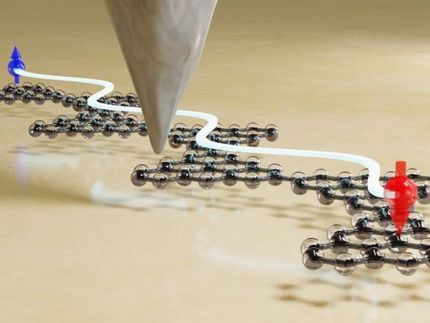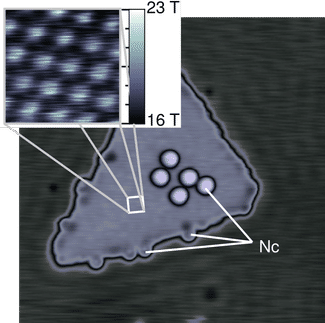Quantum magnets doped with holes
Scientists reveal hidden magnetic order in one-dimensional quantum crystals doped with holes
Advertisement
Magnetism is a phenomenon that we experience in everyday-life quite often. The property, which is observed in materials such as such as iron, is caused by the alignment of electron spins. Even more interesting effects are expected in case that the magnetic crystals exhibit holes, i.e., lattice sites that are not occupied with an electron. Because of the interplay between the motion of the defect and the magnetic correlations of the electron spins, the magnetic order seems to be suppressed. In general, solid state physicists are not able to separate the two processes, so they cannot answer the question, whether the magnetic order is indeed reduced, or whether it is just hidden.

Image of a chain of atoms taken with the quantum gas microscope. It demonstrates that atoms with different spin orientations are spatially separated. If the spin points downwards (green), the atom is located in the lower part of the double well structure of the lattice site, whereas it is in the upper part, if the spin points upwards (red). In addition, the holes can be detected directly.
MPQ, Quantum Many-Body Systems Division
Now a team of scientists around Dr. Christian Groß from the Quantum Many-Body Systems Division (director Professor Immanuel Bloch) at the Max Planck Institute of Quantum Optics has demonstrated that in one-dimensional quantum magnets the magnetic order is preserved even when they are doped with holes – a direct manifestation of spin-charge (density) separation. The quantum crystals were prepared by chains of ultracold atoms in an optical lattice. The observation was made possible with a unique tool which allows tracking the motion of holes and the spin excitations separately in one measurement process. In the next step the scientists plan to extend the method to two-dimensional systems. Here the interaction between holes and magnetic correlations is by far more complex. It could lead to the detection of exotic many-body phases that might be responsible for the occurrence of high-temperature superconductivity.
The Garching team starts with cooling an ensemble of fermionic lithium-6 atoms down to extremely low temperatures, a millionth of a Kelvin above absolute zero. The atoms are then captured in a single plane in a two-dimensional optical lattice that is created by laser beams. The plane in turn is split into about 10 one-dimensional tubes along which the atoms can move. In the last step, the tubes are superimposed with an optical lattice which mimics the periodic potential that electrons see in a real material. In analogy to electrons lithium atoms carry a spin-1/2 (or magnetic moment) which can point either upwards or downwards. In a previous experiment with a similar system the scientists have shown that below a certain temperature the magnetic moments of neighbouring atoms align in opposite directions such that antiferromagnetic correlations emerge.
In the follow up experiment they investigate the influence of holes on the degree of order of the quantum crystal. “We achieve a certain amount of hole doping by making sure that the number of atoms loaded into the optical lattice is smaller than the number of lattice sites,” says Timon Hilker, first author and doctoral candidate at the experiment. “Now the questions arise, whether the holes are fixed or whether they can move, and how they affect the magnetic order of the system.”
We are all familiar with the following situation: if in a theatre a seat in the middle of a row remains empty, a move goes through the crowd: one by one, the members of the audience move up – in other words: the hole migrates. Something similar can be observed in the synthetic quantum crystal with the help of the quantum gas microscope which images the precise position of each single atom or defect on their respective lattice sites. “However, much in contrast to the empty chair in the theatre, the holes in the quantum crystal are delocalized. Their location is determined the very moment they are being measured,” Timon Hilker emphasizes.
At first view the fluctuations of the atoms in the optical lattice hide the antiferromagnetic correlations. But the team of Christian Groß is able to have a closer look, because they have developed a method to spatially separate atoms with different spin orientations. To this end, the optical lattice is superimposed with a superlattice such that a double well is created on each lattice site. In combination with a magnetic gradient this results in a potential which is dependent on the spin-orientation. The big challenge of this method is to adjust optical lattice and superlattice with a precision of a few nanometres, i.e., a fraction of the laser wavelength.
“In our system we can detect simultaneously holes as well as both spin states ,” Dr. Christian Groß, leader of the project, points out. “We can directly investigate the environment of each hole. We observe, that the order is generally preserved, i.e., that the spins of the left and the right neighbour atoms are anti-aligned. Because the images display every spin and every hole, we are able to, as to speak, ‘take the holes out’ in our evaluation. Such non-local measurements are experimental new territory and open new perspectives for the study of exotic phases of matter.”
Now the scientists plan to apply this method to two-dimensional quantum crystals that are doped with holes. This would be a new approach to simulate two-dimensional holes-doped systems of correlated electrons. Experiments of that kind could lead to a better understanding of the so-called high-temperature superconductivity which was detected 30 years ago. The name describes the effect that in certain compounds with layers containing copper the electrical resistance vanishes already above the boiling temperature of liquid nitrogen. The interplay between defects and antiferromagnetic correlations is believed to play an important role in this puzzling phenomenon.






























































